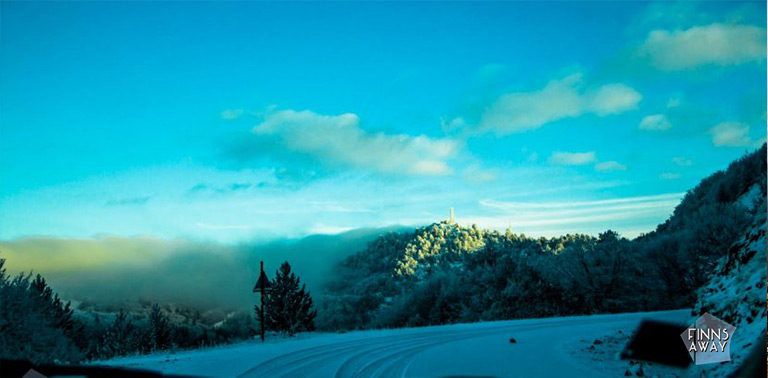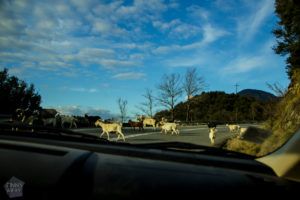
Road trips in Greece: Over Katara pass to Meteora
Greece mainland, especially the northern part of it, is not on every travelers bucket list. The great masses tend to head to the Greek islands, which truly are gorgeous. Or to Athens, the fascinating capital full of history and world-famous attractions. That goes to our earlier travels as well; we visited Greece back in 2012, staying in Rhodes island, and shortly exploring Athens and Thessaloniki on our way to Macedonia and other Balkan countries. So we didn’t really know what to expect from the mainland, and for sure weren’t aware of how mountainous country Greece actually is, and how stunning landscapes also the northern parts offer. This is travel story about our road trip from Albania through Epirus region to Meteora in Central Greece, December 2017.
Before starting to plan our stay in Greece, the main goal was to drive to Athens and then move forward to Peloponnese. Late December, when the weather was getting pretty cold in Albania, we wanted to quickly move to southern parts of Greece for more sun and warmer temperatures. But when searching information about possible stops on the way to Athens, I quickly realized that northern Greece is full of wonderful destinations and we couldn’t just skip all of it and rush to Athens. First idea was hiking in Pindus National Park and in Vikos Gorge area. But as it was a bit too cold for long mountain hikes with our gear, we decided to save those hikes for later. More suitable target for this time of the year was Meteora monasteries and rock formations next to town of Kalabaka in Thessaly region.
From Ksamil to Ioannina
To reach Meteora from Albania, we needed to drive over the Pindus Mountains, that are also called the spine of Greece. This majestic mountain range begins already in southern Albania, and runs roughly 160 kilometers southeast, dividing northern Greece in two. The highest peak in Pindus Mountains is Mount Smolikans with elevation of 2637 meters, and in addition to imposing mountains, there are green valleys and deep, picturesque canyons like Vikos Gorge and Aoos Gorge.
Starting from Ksamil in Albania, we first drove to Kakavia-Ktismata border in northwestern Greece. Crossing the border was a quick process, and we barely needed to show the green card even; seemed that Finnish/EU passports were proof enough to convince the Greek officer that we are good to go. On both sides of the border, we got to admire snow-capped mountain scenery, but the drive to the city of Ioannina was smooth and easy. Ioannina, the capital of Epirus itself would have been worth a visit. It is beautifully located next to lake Pamvotis and the main sights include Ioannina Castle and Ioannina Island with six monasteries.
Drive over Katara pass
The fastest and safest way to drive from Ioannina over Pindus Mountains would have been taking the newish Egnatia-Odos motorway. Egnatia runs through northern Greece from the west coast all the way to Turkish border, and includes numerous long tunnels that make the crossing smoother. But since we are not big fans of road tolls (which by the way are pretty costly for using motorways and tunnels in Greece) and enjoy using small road with better scenery, we chose the old road E92 instead. From Ioannina, the winding road starts to climb towards the mountains. The day was clear and sunny, so the mountainous scenery was just awesome. We were aware, that the road conditions might be challenging and even partly snowy during winter, so there was a plan B to enter the Egnatia motorway if driving would turn out to be too challenging.
But of course we decided to go for it for the whole length of the crossing; all the way up to the highest point of the road, Katara pass (also known as Metsovo pass) in 1 705 meters (5594ft), and down on the other side. Road conditions were fine all the way until Metsovo, and there was not much traffic outside the villages. It seems that close to everyone favors the quick motorway. There were some rocks on the road every now and then, but not that much that it would have caused any problems. And naturally some cows, goats and dogs were blocking the road every once in a while. The snow caps of the mountains seemed to be high up, so we thought that there wouldn’t be snow yet in 1700 meters, and that using Katara pass, would be trouble-free.

What we didn’t know, was that the 18 km long section of the road that climbs over Katara pass from Metsovo has questionable reputation as one of the most dangerous mountain roads at least in Balkans if not the whole Europe. The road trip is said to be only for adventurous drivers even in summer, and only for adrenaline junkies during the winter months, when the road is officially closed and conditions can be extreme with unpredictable weather changes and up to two meters of snow. Oops. Warnings are to be listened, but it seems that there is a lot of false information in internet also, claiming that the road is in too poor condition for driving at all, or that there is no way to drive without off-road 4×4. Yes, there were some potholes and fallen rocks, but at least at the time of our drive, nothing that basic sedan couldn’t get through. Seems that the road is still under maintenance and outside of winter it should be easy enough and very rewarding road trip with jaw-dropping scenery.
But yes, winter tires would have been nice in December. Already before entering the closed upper section of the road, with a barrier and sign ”caution, crossing at your own risk” we reached the snowline. Luckily the road was not that frozen, just snowy, and the depth of the snow wasn’t more than maybe 10 cm at worst. We did have some second thoughts about crossing the pass, as it surely isn’t the wisest move to ignore the warnings, but turning back and using the motorway and tunnel didn’t feel good option either.
So we slowly drove further, past the abandoned looking snowplow station and one turn after another towards the pass. Sunshine and clear mountain views turned to misty, white winter wonderland, that was definitely something that we didn’t expect to see in Greece. The highest point of the road came and went, we didn’t even see the road sign of the pass (guessing it was covered by snow). The road on the other side was pretty much in similar condition; narrowish and snowy, but fine for driving still. After few more kilometers we were again under the snowline and could sigh for relief, we made it through in one piece with our Tiida.
After coming down from Katara pass, the road E92 continues southeast towards Kalabaka, and the motorway leads northeast towards Thessaloniki. The drive down to Kalabaka is also scenic, and the descending road is still winding but in good condition. It was already quite dark when we arrived in Kalabaka, so didn’t get a good glimpse of the Meteora rock formations yet in the first evening. But waking up in the middle of that fascinating landscape wasn’t a bad way to start a new day! Actually it turned out that our timing with crossing the Katara pass had been perfect; it was snowing heavily in northern Greece the next day, so most probably the pass would have been impossible for us to cross anymore.
Related post: Trekking and cliff-top monasteries in magnificent Meteora!




